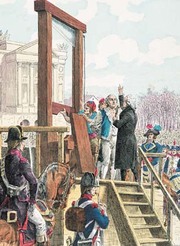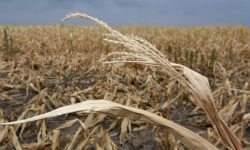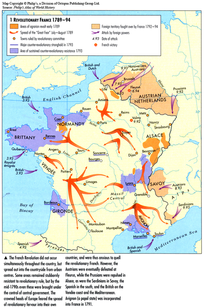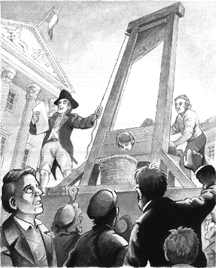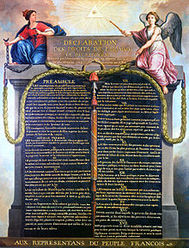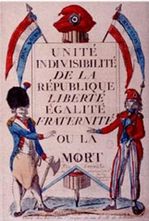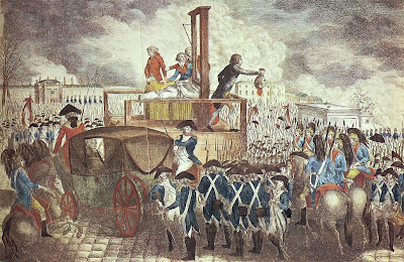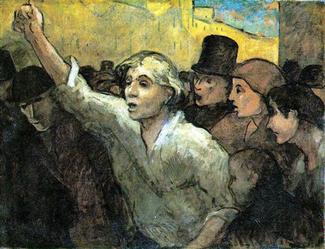AGMSPRITE
AGMS by: Jessalyn Nelson
PRITE by: Elodie Chidiac
Art/Architecture
The French Revolution had a large impact on the aspects of art during that time period. Events that were occurring throughout the revolution along with negative depictions of political figures were constantly being created.With Louis XVI and Marie Antoinette unable to conceive in a timely manner subsequent to their marriage, pornographic images of the two of them were published as a means of mocking them. Many paintings were made with people being executed on the guillotine and the nobility’s heads being paraded around on sticks also portrayed the immense amount of violence that the revolution consisted of. This is extremely similar to today because people continue to publish negative artworks of political figures they are not fond of, such as comics in the newspapers poking fun at President Obama. However, a major change that has occurred is the method of painting. Now photographs are the main means of depicting events happening in a society due to the changes in technology over the years.
|
Geography |
France’s geographic location was also a factor in the revolution. With Austria being a neighboring country, and the birth country of Marie Antoinette, they attempted to invade France and put an end to the chaotic revolution before it spread beyond its borders. Along with Britain, Austria also saw this as an opportunity to weaken France by conquering little areas at a time and ensure that France could not be as powerful as it was before. The land of France itself was also a factor in one of the causes of the revolution. There was a drought in the harvest which caused there to be a vast shortage of flour and bread and caused even more economic hardships for the people of France. Containment is a method still used today in order to prevent chaos spreading from one nation to another. This is different to now because poor harvest is no longer a huge problem for countries because there are other ways to obtain grain if the harvest in the country is bad. |
MilitaryIn an attempt to control Paris, where most of the riotous behavior was taking place, Louis XVI sent 30,000 troops there to go around the city. The people had then formed their own military called the National Guard which required all adult males to serve, consisting of about 800,000 men, the largest in the world, with leaders from the middle and lower classes. The National Guard declared war on the Austrians who attempted to contain the chaos of the French Revolution. Being desperate for an end to the chaos, Marie Antoinette wrote letters to the Austrians, aiding them with information about the military strategies of the National Guard. She was later charged with treason and sentenced to death by the guillotine. Something that has remained constant throughout history is that treason has and always will be punishable by law and for a political figure to commit it is highly frowned upon. However, something that has changed is the fact that revolting parties are able to make armies of that magnitude.
|
Society |
The relationship between the extremely wealthy and the commoners consisted of a great deal of resentment. The wealthy had to pay barely any taxes, had enormous amounts of food, and created all of the laws. The commoners were forced to pay the vast majority of the taxes, were starving due to the bad harvest, and were forced to abide by all of the laws although they had no voice in their creation. The system of the Estates General greatly favored the clergy and the nobility, which made up about three percent of the population, but still had the power to outvote the commoners, the other ninety-seven percent. This immense inequality led for the people to want radical change by creating completely new forms of government and executing every wealthy political figure they could find. The uniform method of execution they used, the guillotine, made this one of the most violent revolution to ever occur. The reasons for murder continued to grow as paranoia swept across the country and anyone suspected of being an anti-revolutionist was sentenced to death. Eventually, the execution of Maximilien Robespierre, the leader of the revolution and the man who sent thousands of people to death, marked an end to the most violent era of the French Revolution. Similarities to today include the fact that there continues to be animosity between classes. The lower classes always crave and are envious of those in the upper classes. A major change has been that there are more fair laws that prevent the upper classes from holding the vast majority of the vote. There is more equality between people that prevents immense animosity between classes and does not lead to large scale violence. |
PoliticalPolitically, the French Revolution ended the monarchical oppression in the country and in addition brought democracy to France and established a whole new order of society even though progress came at a price. King Louis XVI and Marie-Antoinette were weak political leader and France was economically corrupted by the American war. As an instrumental leader, Robespierre helped establish the Declaration of the Rights of Man which defined a set of individual and collective rights for all the people, regardless of their estate. Later France became a constitutional monarchy which demanded that the king must share power with the people in the assembly. The immense shift of power from an oppressive monarchy, ruled by a king and queen, to a republic open the doors of a better era as seen as by the French society.
|
Religion |
During the time of the French Revolution, the teachings of the Catholic Church were challenged by the enlightenment ideas that were spreading across the country. Because of the rise of knowledge and understanding, the Catholic Church lost control and power over the people which decreased their oppressive power over the society. Since religion was always a key for unity, France broke apart with the different social classes and the rise of the revolution. The Revolutionary calendar started with the advent of the French Republic (Year 1). The names of its months reflected the seasons and its ten-day week eliminated Sunday as a day of rest and worship. Although such measures were unevenly applied, and in many cases met with considerable local opposition, they reinforced the message that Christianity had no place in the Republic. The French population gradually split between those who supported the Constitutional Church and those who remained loyal to obstinate priests, initially allowed to continue practicing. In 1795, the Convention announced the separation of church and state. Churches were reopened, priests were released from jail, and both constitutional and refractory priests were permitted to practice on the condition that they promised to respect the laws of the Republic. When Napoleon rose to power in 1799, he recognized that if relations were mended with the Church, it could be used to promote and consolidate his rule throughout France. The French Revolution saw the Catholic Church transformed from an autonomous institution that wielded significant influence to one that was reformed, abolished, and resurrected by the state.
|
IntellectSince the Middle Ages, European society has been broken into three distinct classes that were determined by birth; there was a great divide between the wealth of the nobility and the clergy and the poverty of the peasants. But at the blossom of the eighteenth century, reason and science began to challenge this age old tradition. Most traditions were re-examined and sometimes rejected. Swept up on the current of new innovations and knowledge, Paris now radiance as the new philosophical center of the world with a great flourishing of knowledge and the rise of the age of Enlightenment. Enlightenment thinkers such as Baron de Montesquieu, Jean-Paul Marin and Robespierre shared their enlightenment questioning the beliefs of the Catholic Church and their validity. People started to call for liberty, equality and fraternity as well as demanding universal suffrage. Science was not just an intellectual exercise to give knowledge, but a practical enterprise to give mastery over our world.
|
Technology |
The Age of Enlightenment brought upon an age of innovative technological advances that were occurring in rapid succession. Once man knew how nature worked; they could exploit nature to their advantage, overcome scarcity by scientific innovations in agriculture, overcome disease by scientific research in medicine, and generally improve the life of man by all sorts of developments in technology and industry. Despite Robespierre’s opposition, a new killing machine takes center stage in Paris. Joseph Igneous Guillotine turned old fashion decapitation into a humanitarian experience. The Guillotine earned the nickname of “the national razor” which was a strategy to put everyone to death in a quick and efficient way. Also with the easy access to gun power from the Bastilles, people armed themselves to defend and uphold oath to create a new constitution to represent the people of France. |
EconomicEconomically, nearly a decade earlier, King Louis XV lost the seven years war battling Great Britain over territory in North America. The ill faded conflict over bankrupted France of money and prestige leaving the country’s coffers drain even as the population is still growing. Fewer people are dying from the plague but more and more are suffering from hunger. America bankrupts France because the debt the French monarchy invested to fight the American War of Independence turns out to be absolutely crucial in the financial situation of the France monarchy. While Louis spread troops around the world, Marie-Antoinette corrupted France from Versailles with her obsession of fashion, gambling and musical plays. During the French Revolution, the new government had to command revenues in a sensible fashion and keep the nation solvent away from chaotic results. Bad harvest brought about food shortages and hence high prices. The economic conditions of the revolutionary years helped fuel the third estate to speak out about their living status. Globally, France continued to export sugar, coffee and ivory from its colonized nations in the Caribbean.
|
Works Cited:
Alexander, Nicole. "What Types of Art Thrived During the French Revolution?" EHow. Demand Media, 15 May 2011. Web. 29 Mar. 2013.
<http://www.ehow.com/info_8423020_types-thrived-during-french-revolution.html>.
"The French Revolution and the Catholic Church." History Today. N.p., n.d. Web. 28 Mar. 2013."American Revolution." Wikipedia. Wikimedia Foundation, 28
Mar. 2013. Web. 28 Mar. 2013.
"Story of the French Revolution." YouTube. YouTube, 29 Oct. 2011. Web. 28 Mar. 2013.
Strayer, Robert W. "Atlantic Revolutions and Their Echoes, 1750-1914." Ways of the World: A Global History with Sources, 2nd Ed.,. [S.l.]: Bedford Bks
St Martin'S, 2013. 784-87. Print.
<http://www.ehow.com/info_8423020_types-thrived-during-french-revolution.html>.
"The French Revolution and the Catholic Church." History Today. N.p., n.d. Web. 28 Mar. 2013."American Revolution." Wikipedia. Wikimedia Foundation, 28
Mar. 2013. Web. 28 Mar. 2013.
"Story of the French Revolution." YouTube. YouTube, 29 Oct. 2011. Web. 28 Mar. 2013.
Strayer, Robert W. "Atlantic Revolutions and Their Echoes, 1750-1914." Ways of the World: A Global History with Sources, 2nd Ed.,. [S.l.]: Bedford Bks
St Martin'S, 2013. 784-87. Print.
